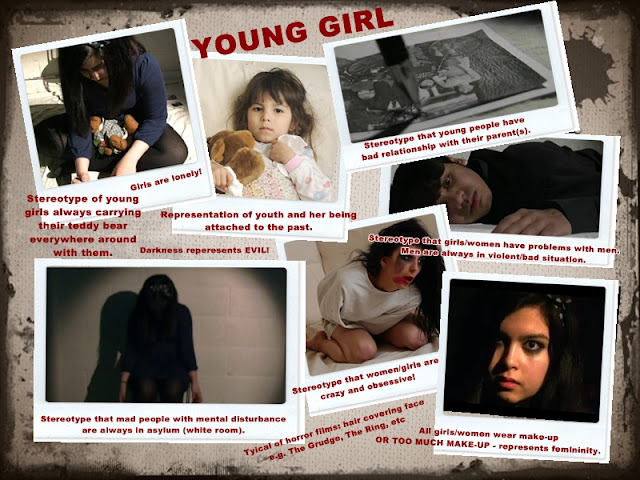How does your media product represent particular social groups?
What is representation?
Representation is the description or portrayal of someone or something in a particular way or as being of a certain nature. It is the way in which people of certain social groups are characterised and recognised by. It refers to the precise reconstruction of the 'real world' in any medium aspect of reality such as people, identities, places, etc. Representation which are commonly used are: gender, age, race and disability. A popular understanding of representation is through stereotypes e.g. teenagers are rebellious and reckless, women are vulnerable and victims.
What is a social group?
People sharing some social relation.
In our thriller film, we decided to represent the younger age group through the use of the main character. We did this through the use of mise en scene; for example, the young girl wore a lot of make-up, giving the impression that all girls wear (TOO MUCH) make-up or like make-up.
Our film opening for 'Obsession' represents the social group in many ways. I would say mainly negative than positive as shown below (picture collage I created on Photoscape). The positive representation of our film is that men are the goodies in this situation, as the girl is the killer in this film! -this breaks the general representations and stereotypes. Our film doesn't have as many stereotype as majority of the film out there, this is because the plot is twisted and unique. However, this doesn't make our film is unrelatable as we still have some stereotypes/relatable representation. I think the fact that the film isn't typical makes the whole thing more interesting!
Social groups that we have represented in our opening:
GENDER:
Representation of gender is presented through the main character in our opening. She is a girl and that is revealed through the use of camerawork and shots - close up shots and other shot like wide shots clearly showed that she is a girl. The make-up and dress as part of the (mise en scene) revealed her femininity, revealing her gender. We also included stereotypes of females such as: all girls wear make up.
DISABILITY:
Representation of disability is presented through the use unsteady and shaky camerawork in certain parts of the opening. The shaky effect and flashing light effects done in the editing process reveals that she is disturbed and reflects her mind and behaviour. The setting is in asylum which suggests that she is mentally disabled. People usually associate white trapped rooms as a place where disabled people stay, and this is portrayed in our opening. We also included stereotypes of disability; for example: mad people with metal disability are always in asylums.
AGE:
Representation of age is presented through the use of close-up shots, showing her face which clearly reveals that she is of a young age as her skin is youthful and she doesn't have an wrinkles. It is clear that she is young and in her early teen years as the props (teddy bear) and costume (ribbon and short childlike dress) are associated to people of a younger age. The white room connotes her innocence which hints that she is still young. Stereotypes are also indicated in our opening; for example young people/girls always carry around a toy (teddy bear) with them everywhere.
Social groups that we have represented in our opening:
Representation of gender is presented through the main character in our opening. She is a girl and that is revealed through the use of camerawork and shots - close up shots and other shot like wide shots clearly showed that she is a girl. The make-up and dress as part of the (mise en scene) revealed her femininity, revealing her gender. We also included stereotypes of females such as: all girls wear make up.
DISABILITY:
Representation of disability is presented through the use unsteady and shaky camerawork in certain parts of the opening. The shaky effect and flashing light effects done in the editing process reveals that she is disturbed and reflects her mind and behaviour. The setting is in asylum which suggests that she is mentally disabled. People usually associate white trapped rooms as a place where disabled people stay, and this is portrayed in our opening. We also included stereotypes of disability; for example: mad people with metal disability are always in asylums.
AGE:
Representation of age is presented through the use of close-up shots, showing her face which clearly reveals that she is of a young age as her skin is youthful and she doesn't have an wrinkles. It is clear that she is young and in her early teen years as the props (teddy bear) and costume (ribbon and short childlike dress) are associated to people of a younger age. The white room connotes her innocence which hints that she is still young. Stereotypes are also indicated in our opening; for example young people/girls always carry around a toy (teddy bear) with them everywhere.



No comments:
Post a Comment